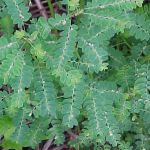| Common Name: |
Niruri |
| Other Names: |
Chanca Piedra, Dukong Anak, Derriere Dos, Jaramla, Rami Bush, Seed on the Leaf |
| Botanical Name: |
Phyllanthus niruri syn. P. debilis |
| Genus: |
Phyllanthus |
| Family: |
Euphorbiaceae |
| Native Location: |
Tropical Asia, Amazon |
| Cultivation: |
Well-drained soil in sun with high humidity. |
| Propagation: |
By seed sown when ripe. |
| Harvest: |
Whole plants are collected during summer and autumn and used fresh or dried in decoctions, or pounded with roots as a poultice. Fruits are collected when unripe or ripe for decoctions, powder, and candy. Roots and bark are collected as required for decoctions. |
| Height: |
40-50cm (16-20in) |
| Width: |
15-25cm (6-10in) |
| Hardiness: |
Tender |
| Parts Used: |
Whole plant |
| Properties: |
A cooling, bitter, astringent herb that relaxes spasms, improves digestion, and has potent diuretic effects; also lowers blood sugar. |
| Medicinal Uses: |
Internally for urinary tract infections, urinary stones, diarrhea, gonorrhea, jaundice, yellow fever, and diabetes. Externally for sores, ulcers, wounds, bruises, scabies, ringworm, and eye infections.
To treat urinary tract infections, poor appetite, constipation, the flu, and pain. |
| Possible Side Effects: |
Chanca piedra has no reported side effects when used properly under a physician's supervision. |
| Drug Interactions: |
| Taking chanca piedra with these drugs may increase the risk of hypoglycemia (low blood sugar): |
| Acarbose, (Prandase, Precose) |
Acetohexamide, (Acetohexamide) |
Chlorpropamide, (Diabinese, Novo-Propamide) |
Gliclazide, (Diamicron, Novo-Gliclazide) |
| Glimepiride, (Amaryl) |
Glipizide, (Glucotrol) |
Glipizide and Metformin, (Metaglip) |
Gliquidone, (Beglynor, Glurenorm) |
| Glyburide, (DiaBeta, Micronase) |
Glyburide and Metformin, (Glucovance) |
Insulin, (Humulin, Novolin R) |
Metformin, (Glucophage, Riomet) |
| Miglitol, (Glyset) |
Nateglinide, (Starlix) |
Pioglitazone, (Actos) |
Repaglinide, (GlucoNorm, Prandin) |
| Rosiglitazone, (Avandia) |
Rosiglitazone and Metformin, (Avandamet) |
Tolazamide, (Tolinase) |
Tolbutamide, (Apo-Tolbutamide, Tol-Tab) |
|
| Bibliography: |
Encylopedia of Herbs by Deni Brown Copyright ©: 1995, 2001 Dorling Kindersley Limited pps. 312-313
The Essential Herb-Drug-Vitamin Interaction Guide by Geo. T. Grosberg,MD and Barry Fox,PhD Copyright©2007 Barry Fox,PhD. Pp 141-142 |

